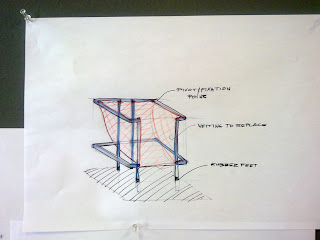furniture.reinterpret.2012s1@gmail.com
Butterfly Stool ( Sori Yanagi)
Butterfly stool is designed by Sori Yanagi (Japanese, 1915-2011) in 1956. It is made with moulded plywood and metal. It is a stool with 15 1/2 “(39.4cm) in height, 17 3/8 “(44.1 cm) in width and 12 1/8” (30.8cm) in length. The researches of this stool are all carried out from Charles and Ray Eames moulded plywood in California to Arne Jacobsen in Denmark.
It is combination of eastern aesthetic and western technology. According to Design classic living from (October 13, 2002, p. 12), “two double-curved pieces of plywood are bolted together where they touch, to make a comfortable and beautiful stool.”” The gently curved silhouette is reminiscent of the wings of a butterfly.”(Sori Yanagi Butterfly stool from Bonluxat 2012). The nickel- brass rod prevents the two curve pieces of plywood from dividing and keeps them stable. The shape of the chair is abstract from the temple of samurai mask and also from butterfly. It became fashionable since 1950s and it works as zen-like spaces for interior. Regarding the “Sori Yangi, Japanese industrial design pioneer, pass away” from core77 in 2011, this stool win an award in 1957 Milan Trienniale and now it is exhibited this chair in both MoMA museum and louvre.

Analysing the structure of the stool, two curve components join together in the middle and supported by roughly 60 degree angle plywood from the floor. The sloping plywood supported by against each other on the top of stool. When the user sit on this stool, it will create force in the middle to downward and that will make the two components far apart. This thing is prevented by the brass fixing element at the lower part of the stool. These ideas create the stool unique and elegance. That’s why it become the icon in design.
Pearman, H 2002, “Design classics; Living”, Sunday Times, London, England, October 13, p.12,
MoMa 2012, “Butterfly stools: Sori Yangi (Japanese 1915 -2011),
http://image.rakuten.co.jp/lamiavita/cabinet/img55529643.jpg




























